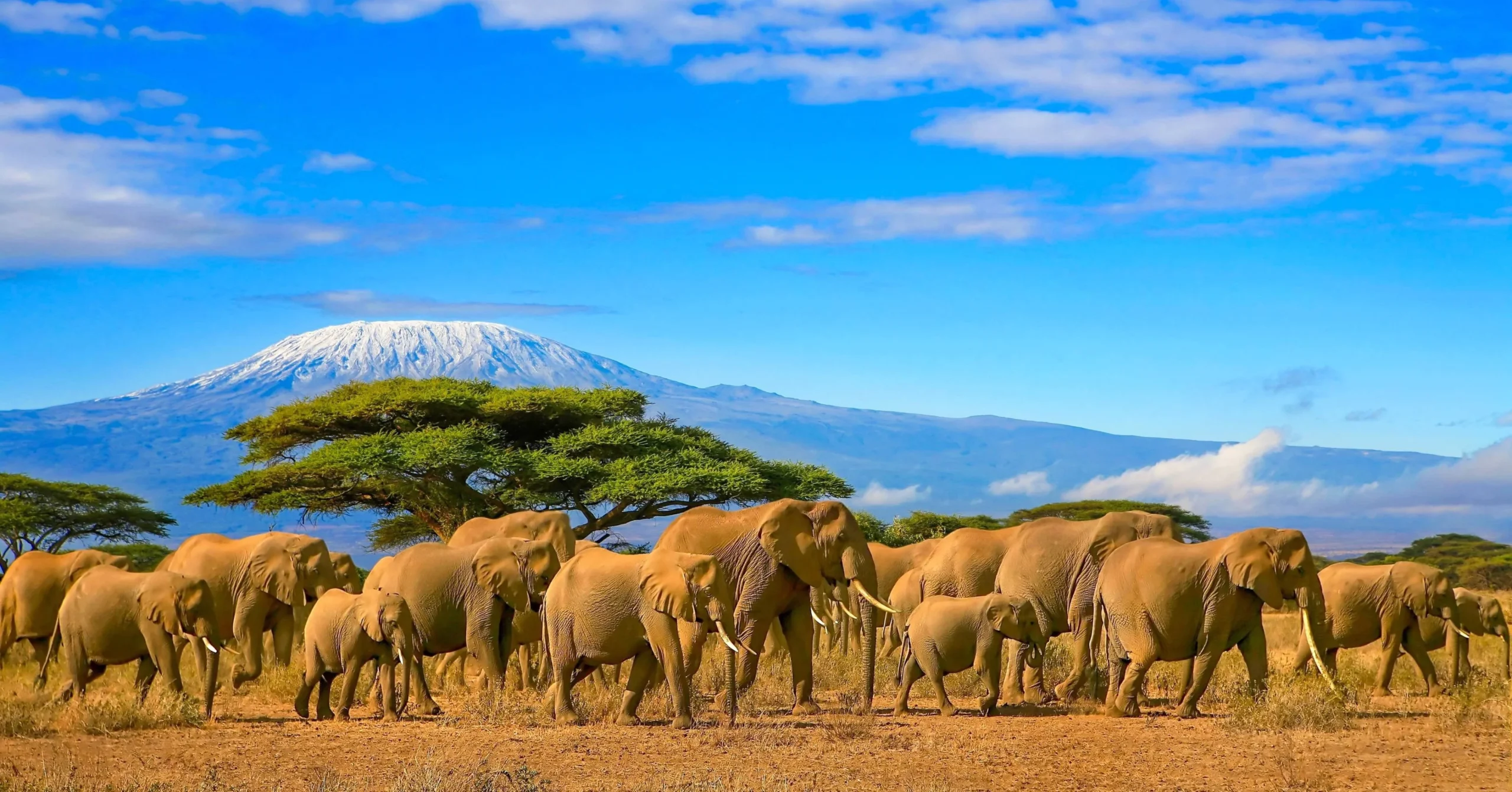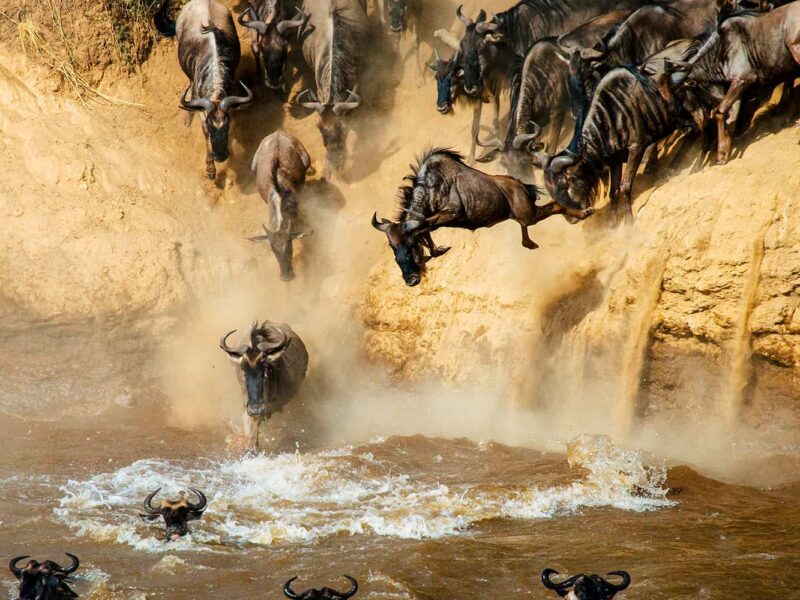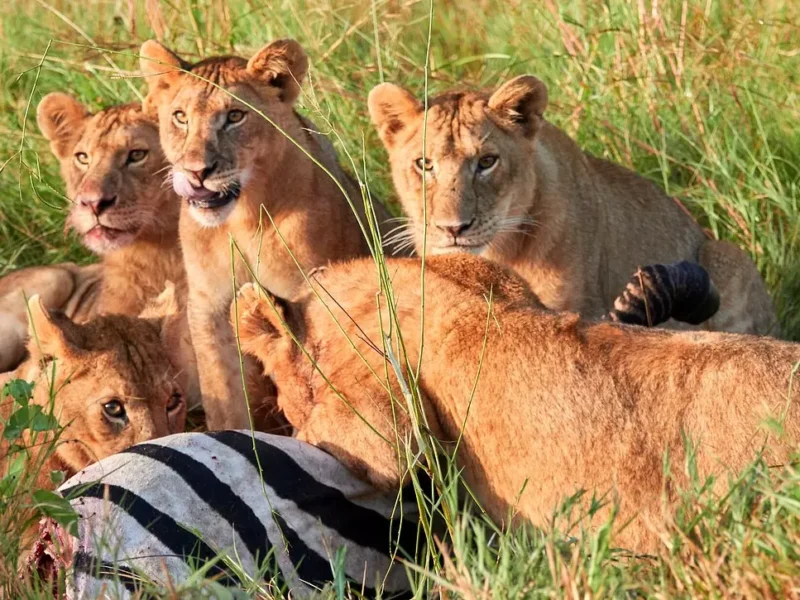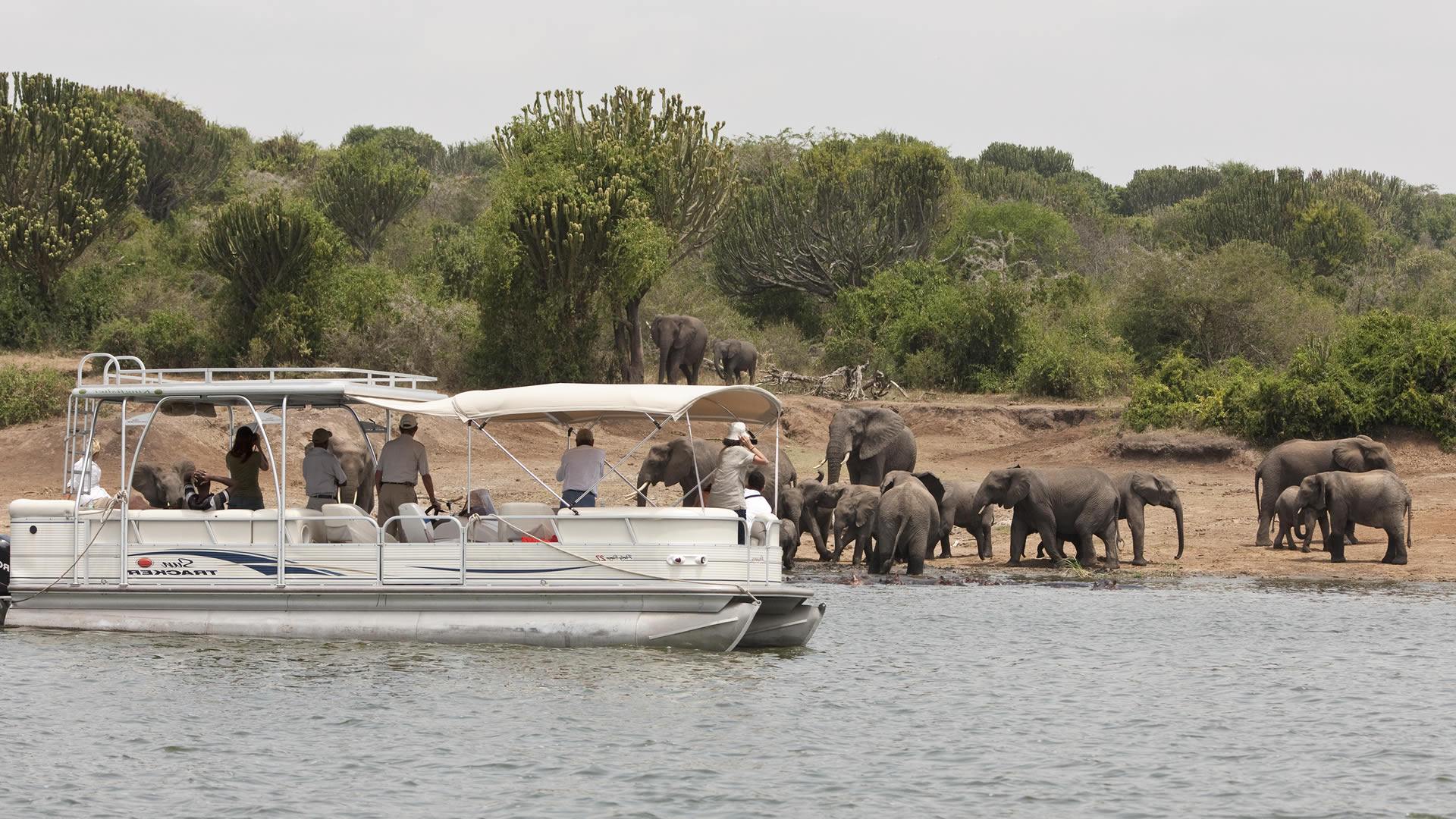
Queen Elizabeth National Park
April 1, 2025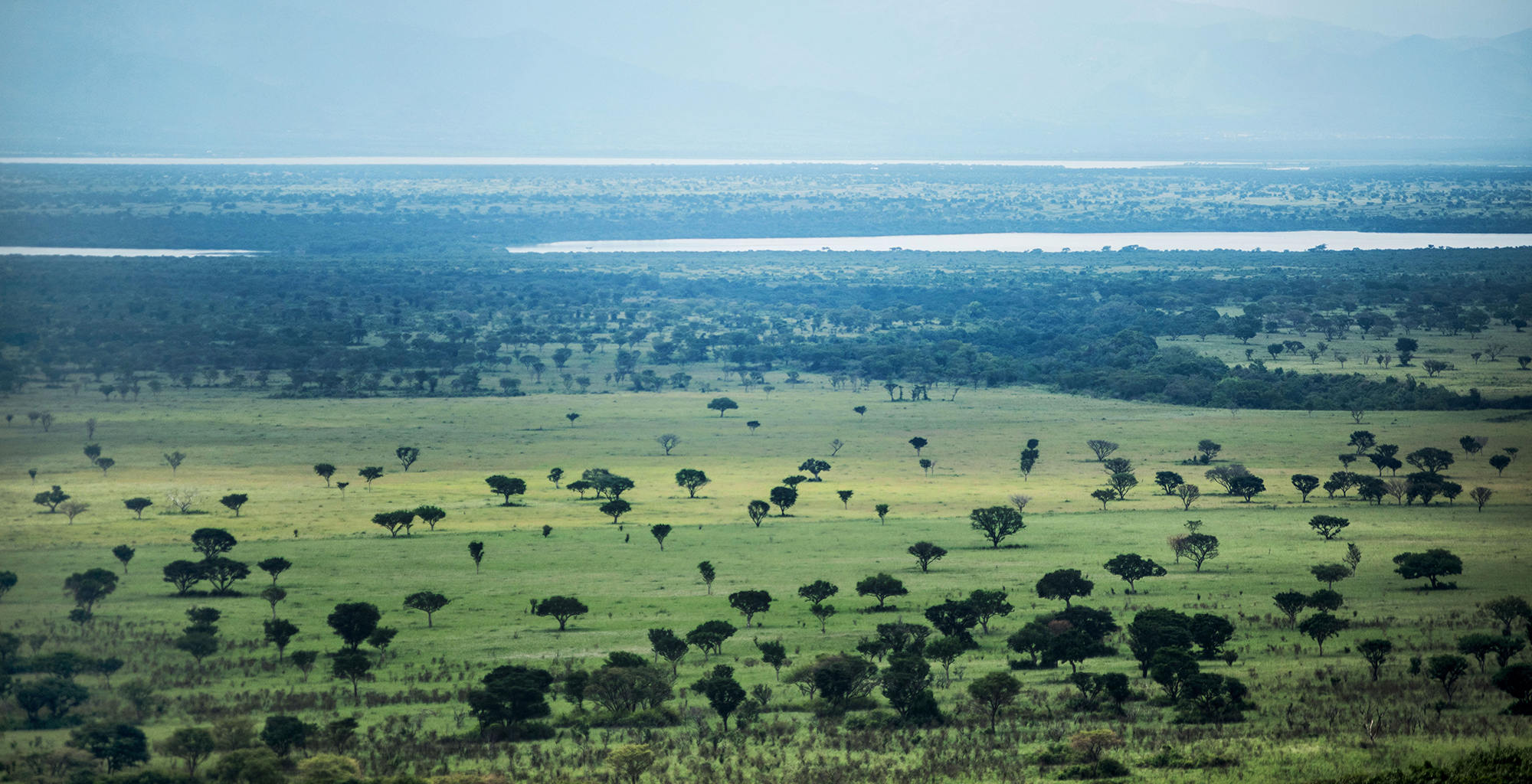
Murchison Falls National Park
April 1, 2025Amboseli National Park:
A Majestic Destination in Kenya
Amboseli National Park, located in southern Kenya near the border with Tanzania, is one of the country’s most iconic wildlife reserves. It is renowned for its breathtaking views of Mount Kilimanjaro, Africa’s highest peak, and its exceptional wildlife, particularly large herds of elephants. Covering 392 square kilometers (151 square miles), Amboseli is famous for its rich diversity of landscapes, from savannah grasslands to swamps and wetlands, making it a prime destination for wildlife lovers, photographers, and nature enthusiasts alike.
Geography and Landscape of Amboseli National Park
Amboseli National Park, located in southern Kenya near the border with Tanzania, is one of the country’s most beloved wildlife destinations. Renowned for its rich diversity of ecosystems and dramatic views, the park’s geography and landscape create a unique and captivating environment for both wildlife and visitors. This area is home to wide-ranging landscapes, from dry savannahs to lush wetlands, and provides a backdrop of Mount Kilimanjaro, Africa’s tallest peak, which adds to the park’s iconic appeal.
1. Location and Size
– Location: Amboseli National Park is situated in Kajiado County, approximately 240 kilometers (150 miles) southeast of Nairobi, Kenya’s capital. Its location on the southern border of Kenya places it near the Tanzania border, making it a vital part of the Greater Amboseli Ecosystem, which extends into northern Tanzania.
– Size: Covering an area of 392 square kilometers (151 square miles), the park is not one of Kenya’s largest national parks but is a significant area of diverse habitats within its confines. Despite its size, the park provides a variety of landscapes and environments, creating different wildlife viewing opportunities throughout the year.
2. Mount Kilimanjaro
One of the park’s most defining features is its proximity to Mount Kilimanjaro, which towers over Amboseli at 5,895 meters (19,341 feet) above sea level. The mountain is located just across the border in Tanzania, but its towering presence is felt throughout the park.
– Kilimanjaro’s Influence: The park’s unique geography is shaped by Mount Kilimanjaro’s climatic and geological influence. The mountain is surrounded by cloud forests on its lower slopes and glaciers at its peak, but its lower regions play a significant role in the surrounding Amboseli landscape. The snow-capped peak of Kilimanjaro is one of the most iconic views in Africa and provides visitors with spectacular panoramic backdrops, particularly at sunrise and sunset.
– Water Supply from Kilimanjaro: The mountain’s glaciers and ice fields, along with rainfall, feed underground rivers and aquifers that flow to Amboseli. These underground water sources surface in the park’s wetlands and swamp areas, creating a vital source of water for both wildlife and vegetation in an otherwise arid environment.
3. The Wetlands and Swamps
The Amboseli Swamp, located in the central part of the park, is one of its most critical and ecologically significant areas. The swamp is fed by water from Mount Kilimanjaro’s glaciers and underground springs, making it a year-round water source in a region that can otherwise be dry and parched.
– The Swamp Ecosystem: This lush area of the park is a vibrant and biodiverse zone. During the dry season, the swamp becomes a gathering point for large herds of elephants, buffaloes, and other herbivores that come to drink from the water. This makes the swamp an excellent place for wildlife viewing. In addition, the swamp is home to a variety of birds, including flamingos, herons, and pelicans, making it a prime location for bird watching.
– Vegetation: The vegetation around the swamps is predominantly marshland and wetland grasses, such as papyrus reeds and sedges. These wetlands contrast with the surrounding dry savannah, creating a diverse habitat for a variety of animals.
4. Savannas and Grasslands
Much of the Amboseli landscape is composed of open savannah grasslands, which are characterized by expansive, flat plains dotted with acacia trees and small shrubbery. This dry, open landscape is perfect for game viewing, as it allows for excellent visibility of wildlife, particularly large herds of herbivores.
– Vegetation: The savannah areas are dominated by grasses, acacia trees, and shrubs. Acacia trees are the most common, often providing shade and shelter for animals like giraffes, zebras, and gazelles. These grasslands are also important for grazers such as wildebeest, gazelles, and buffaloes, which graze on the fresh grasses that grow after the rains.
– Landforms: The savannah also includes salt flats and dry riverbeds (often known as dambos). These riverbeds are seasonal, only flowing during periods of rainfall. When dry, they create wide open spaces that animals often cross, making them ideal for sightings of predators like lions, cheetahs, and hyenas.
5. Acacia Woodlands
In addition to the vast grasslands, Amboseli features a number of acacia woodlands, which provide important habitats for many species. These woodlands are generally found in the northern and eastern parts of the park and consist of dense thickets of acacia trees interspersed with open areas of grass.
– Animal Habitat: The woodlands provide shelter and food for a variety of species, including smaller mammals like bushbucks, dik-diks, and the larger giraffes, which feed on the acacia leaves. Predators like lions and cheetahs can also be found in these areas, where they hunt their prey in the open grassland.
– Birdlife: The acacia woodlands are also home to many bird species, such as eagles, vultures, hornbills, and kingfishers, which nest in the trees or hunt in the open spaces nearby.
6. The Olkilorit Desert and Other Arid Regions
To the southeast of the park lies the Olkilorit Desert, a stark, dry region that contrasts sharply with the wetter zones of the park. This desert-like area is made up of arid terrain and rocky outcrops, with very little vegetation and sparse rainfall.
– Landforms and Vegetation: The Olkilorit Desert consists of salt pans, sand dunes, and dry riverbeds. It’s a harsh environment where only the most resilient plant species, like desert grasses and low shrubs, can survive.
– Wildlife Adaptations: Despite the aridity, the desert area is home to a variety of wildlife adapted to the harsh conditions. This includes hardy species like gazelles, jackals, and hyenas, which have learned to survive in the arid landscapes. Occasionally, larger predators like lions can also be spotted here, as they travel across the park in search of prey.
7. Climate and Weather
Amboseli is classified as an arid or semi-arid area, and its climate is influenced by the surrounding mountains and its position at the foot of Mount Kilimanjaro. The park receives relatively low rainfall compared to other regions in Kenya.
– Rainfall: The rainfall in Amboseli is seasonal, typically occurring in two main periods: the long rains (from March to May) and the short rains (from November to December). However, despite the seasonal rains, the park remains dry for most of the year.
– Temperature: The temperatures in Amboseli can vary, with hot days reaching over 30°C (86°F) during the day, particularly in the dry season. Nights can be cooler, especially in the more arid regions of the park. The combination of heat during the day and cool nights adds to the park’s unique climatic experience.
8. The Greater Amboseli Ecosystem
Amboseli is part of the Greater Amboseli Ecosystem, which includes adjacent areas like the Chyulu Hills to the northeast and the Tanzania’s Serengeti National Park to the south. The Greater Amboseli Ecosystem is an important migration corridor for wildlife, especially elephants, and it is one of the most vital ecosystems for wildlife conservation in East Africa.
– Migration Routes: Elephants, wildebeest, zebras, and other herbivores migrate across the ecosystem, often traveling between Amboseli and the neighboring parks in both Kenya and Tanzania. This migration plays a crucial role in maintaining the genetic diversity of the species and helps ensure the survival of various animal populations.
The geography and landscape of Amboseli National Park are what make it so unique and special. From the iconic Mount Kilimanjaro to the expansive savannah grasslands, the lush wetlands, and the stark deserts, Amboseli offers a rich tapestry of habitats that support a wide array of wildlife and plants. The diverse ecosystems within the park not only make it a premier safari destination but also highlight the resilience of nature and the adaptability of the animals that call this extraordinary place home. Whether you’re exploring the wetlands, traversing the dry savannah, or enjoying the view of Kilimanjaro, the geography of Amboseli contributes to an unforgettable experience.
Wildlife in Amboseli National Park: A Rich Tapestry of Africa’s Fauna
Amboseli National Park, located in southern Kenya, is renowned for its extraordinary wildlife and rich biodiversity. The park is often considered one of the best places in the world for wildlife viewing, offering visitors the chance to observe animals in their natural habitats against the stunning backdrop of Mount Kilimanjaro. With a mix of savannah, wetlands, acacia woodlands, and seasonal swamps, Amboseli supports a vast array of animals, from large herds of elephants to elusive predators and an impressive variety of bird species.
Here’s a detailed look at the wildlife of Amboseli National Park:
1. Elephants
Amboseli is perhaps most famous for its elephant population, which is one of the largest and most well-studied in Africa. The park is home to over 1,000 elephants, including both resident and migratory herds. Elephants are the park’s main attraction, with their large size, social structure, and behavior making them a highlight of any safari.
– Elephant Herds: Amboseli’s elephants are known for their large tusks and iconic appearance. Many of the elephants in Amboseli are long-term residents, and some are quite famous, with individual elephants becoming well-known through the park’s ongoing research.
– Elephant Research: The Amboseli Elephant Research Project, one of the longest-running wildlife research programs in the world, has provided significant insights into the behavior, social structure, and conservation of elephants. The project, led by Dr. Cynthia Moss and others, has contributed significantly to the understanding of elephant social dynamics, especially the role of matriarchs and family units.
– Elephants and Kilimanjaro: The sight of elephants grazing against the backdrop of Mount Kilimanjaro is one of the most iconic images in African wildlife photography, and Amboseli provides numerous opportunities to capture such stunning scenes.
2. Big Cats
Amboseli is home to a range of large predators, particularly the big cats that roam the park’s diverse landscapes.
– Lions: Lions are commonly seen in Amboseli, especially in the open savannahs and around the swamps where herbivores gather. The lions in Amboseli are known for their hunting prowess and social structure. They are typically found in prides, and they often hunt in the early morning or late afternoon when the prey is most active. The park has been the subject of extensive lion research, making it one of the best places to study lion behavior.
– Cheetahs: Cheetahs are another notable predator in Amboseli, and they can be seen sprinting across the open grasslands as they hunt for antelopes, particularly Thomson’s gazelles. Cheetahs rely on speed for hunting, and visitors may catch a glimpse of them in pursuit of prey. They are less social than lions, and can often be spotted alone or in small groups.
– Leopards: Leopards are more elusive than lions and cheetahs, but they do inhabit Amboseli’s woodlands and rocky outcrops. They are solitary creatures, and sightings are rare. Leopards are opportunistic hunters and often prey on smaller animals like impalas, baboon, and small mammals.
– Hyenas: Spotted hyenas are common in Amboseli and are often seen scavenging around the park. They are opportunistic feeders, often hunting in groups or scavenging the kills of other predators. Hyenas are an important part of the ecosystem as they help clean up carcasses.
3. Herbivores
Amboseli’s diverse landscapes, including open plains, woodlands, and wetlands, support a variety of herbivores. The abundance of food sources, especially during the wet season, ensures that the park’s herbivores remain well-fed and abundant.
– African Elephants: As mentioned earlier, Amboseli has a large population of elephants, and these herbivores roam freely across the park. Their large size makes them a dominant presence in the ecosystem.
– Wildebeests: Blue wildebeest (also known as gnu) are common in Amboseli, particularly during the wet season when they graze on the fresh grass. These herbivores are an important part of the food chain, serving as prey for predators such as lions and hyenas. Wildebeest also engage in seasonal migrations, moving between Amboseli and neighboring ecosystems.
– Zebras: Burchell’s zebra, with its distinctive black-and-white stripes, is another common sight in Amboseli. Zebras are often seen grazing in herds, and they are an important food source for predators. Their presence in Amboseli, particularly around the wetland areas, adds to the biodiversity of the park.
– Giraffes: Masai giraffes are prevalent in Amboseli, especially in the wooded areas. They feed on acacia trees and can be found wandering the savannahs in search of food. Giraffes’ long necks and legs make them well-suited to reaching the high branches of trees.
– Buffaloes: African buffaloes are another large herbivore found in Amboseli. These herds of strong, social animals often gather around water sources, such as the Amboseli Swamp, and are often seen in large numbers. Buffaloes are a keystone species, playing a significant role in maintaining the park’s grassland ecology.
– Antelope Species: Several species of antelope call Amboseli home. The Thomson’s gazelle, Grant’s gazelle, impala, and eld’s dik-dik are commonly seen grazing in the park. These antelopes are essential prey for predators and serve as a primary food source for carnivores.
4. Smaller Mammals and Primates
In addition to the larger mammals, Amboseli is also home to a variety of smaller mammals and primates that contribute to the park’s rich biodiversity.
– Baboons: Yellow baboons are one of the most common primates found in Amboseli. They are often seen in large troops near water sources or feeding on fruits and plants. Baboons are highly social animals and are known for their complex social structures.
– Monkeys: Vervet monkeys are common in Amboseli, often seen in the park’s woodlands or around the lodges. They are small and agile, feeding on fruits, insects, and small animals.
– Jackals: Golden jackals are often seen in Amboseli’s open areas. They are scavengers and opportunistic hunters, preying on small mammals, birds, and even stealing from larger predators like lions or cheetahs.
– Hares and Mice: Small mammals such as scrub hares and various species of mice are found in the park and provide food for carnivores and birds of prey. They are nocturnal, making them harder to spot during the day.
5. Birdlife
Amboseli National Park is a birdwatcher’s paradise, with over 400 bird species recorded. The combination of wetlands, swamps, savannah, and woodlands creates diverse habitats that support a variety of bird species, both resident and migratory.
– Flamingos: The park’s wetlands, especially the Amboseli Swamp, attract large numbers of greater and lesser flamingos. These birds are often seen wading through the shallow waters of the swamp in search of food.
– Raptors: The park is home to a variety of birds of prey, including eagles, vultures, and buzzards. The tawny eagle, steppe eagle, and white-backed vulture are just a few examples that can be spotted soaring above the savannah, searching for prey or carrion.
– Waterfowl: The wetlands of Amboseli support numerous species of waterfowl, such as pelicans, egrets, herons, and kingfishers. These birds thrive in the park’s marshes, where they hunt for fish and amphibians.
– Other Species: A variety of smaller bird species can also be found in the park, including hornbills, sparrows, and larks, which inhabit the savannah and woodland areas.
6. Reptiles and Amphibians
While Amboseli is primarily known for its mammals and birds, the park also supports a number of reptiles and amphibians.
– Snakes: Various species of snakes, including the puff adder, black mamba, and cobra, can be found in the park. However, these reptiles are often shy and tend to avoid human interaction.
– Tortoises: Leopard tortoises are common in Amboseli and can often be spotted in the grasslands or near water sources. They are slow-moving and spend much of their time foraging for vegetation.
– Frogs: The swamps and wetlands are home to various frog species, which thrive in the moist conditions.
Amboseli National Park is a rich, diverse wildlife sanctuary, home to an incredible array of species, including large mammals like elephants, lions, and giraffes, as well as numerous bird species, reptiles, and smaller mammals. The park’s varied landscapes—from wetlands to savannahs and woodlands—create ideal habitats for its diverse wildlife, making it one of the best places for wildlife viewing in Africa. Whether you are interested in observing majestic elephants, tracking elusive predators, or enjoying birdwatching, Amboseli offers an unforgettable experience for nature lovers and safari enthusiasts alike.

